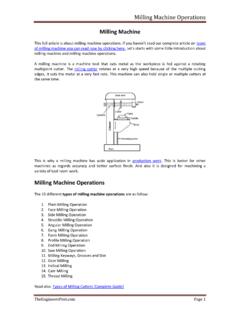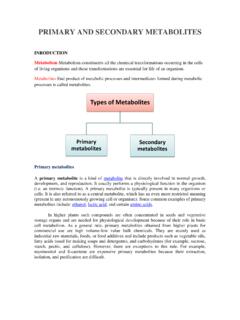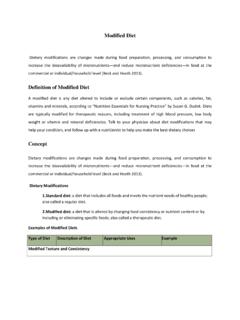Transcription of Farming Systems and Sustainable Agriculture
1 Farming Systems and Sustainable Agriculture Rao Course outline 1. Course No. : AGRO 303 2. Course Title : Farming Systems and Sustainable Agriculture 3. Credit Hours : 2 (1+1) 4. General Objective : (i) To impart knowledge to the students on the fundamentals of Farming Systems and Sustainable Agriculture (ii) To study the various components of organic Agriculture 5. Specific Objectives a) Theory By the end of the course, the students will be able to i. learn the fundamental principles of Farming Systems and Sustainable Agriculture and how to improve the economic condition of the farmer b) Practical By the end of the practical exercises, the students will be able to i.
2 Learn skills involved in vermiculture, sericulture, dairying, poultry, composting and biocontrol of pests ii. learn the methods involved in preparation of cropping pattern and Farming system to be adopted by the farmer A) Theory Lecture Outlines 1. Sustainable Agriculture introduction adverse effects of modern Agriculture definition concept goals elements and current status of Sustainable Agriculture in India. 2. Factors effecting ecological balance and sustainability of agricultural resources introduction land / soil related problems soil degradation, deforestation, accelerated soil erosion, siltation of reservoirs etc.
3 Causes and extent of these problems in India and ameliorative measures. 3. Rise in water table water logging salinization and alkalization in command areas extent of these problems in India and Andhra Pradesh prevention, control and reclamation measures sea water inundation and sand casting during cyclonic storms and their effects on Agriculture . 4. Ground water development resource availability in India and Andhra Pradesh Groundwater development scenario over exploitation problems and safe yield concept artificial recharge methods 5. Environmental pollution Introduction greenhouse effect and potential effects on Agriculture depletion of ozone layer, methane emissions from rice fields and mitigation options 6.
4 Fertilizers as a source of pollution and control measures introduction nitrate pollution in soil and ground water and eutrophication management factors to reduce fertilizer pollution 7. Pesticides as source of pollution and control measures bio-pesticides and bio-herbicides 8. Management of natural resources introduction land water irrigation problems Impact on Low External Input Agriculture (ILEIA) and Low External Inputs for Sustainable Agriculture (LEISA) vegetative cover present scenario and management practices 9. Conjunctive use of water definition objectives types advantages and limitations wasteland and their management definition classification distribution in India and Andhra Pradesh need for development and regenerative measures 10.
5 Organic Farming definition principles relevance to modern Agriculture and components of organic Farming integrated nutrient management 11. Organic Farming practices weed management pest management 12. Farming Systems system and Systems approach Farming system determinants of Farming system cropping Systems and related terminology 13. Study of allied enterprises significance of integrating crop and livestock dairying and sheep and goat rearing breeds housing feed and fodder requirements biogas plant 14. Study of allied enterprises poultry Farming breeds housing feed and fodder requirements apiculture species and management 15.
6 Study of allied enterprises sericulture moriculture and silkworm rearing agro-forestry Systems suitable for dryland Farming 16. Biodiversity importance agricultural intensification and biodiversity adverse impacts of genetic erosion conservation of natural resources B) Practical Class Outlines 1. Preparation of cropping scheme to suit different irrigated and garden land situations 2. Preparation of Farming Systems to suit to dryland situation 3. Compost making 4. Vermicompost 5. Preparation of enriched farmyard manure 6. Recycling of urban waste 7. Use of bio-pesticides 8. Preparation of project proposals for land development 9. Management of problematic soils 10.
7 Management practices to prevent environmental deterioration for Sustainable Agriculture 11. Visit to wetland farm observation on resource allocation, recycling of inputs and economics 12. Visit to garden land farm observation on resource allocation, recycling of inputs and economics 13. Visit to dry land farm observation on resource allocation, recycling of inputs and economics 14. Methods of profitable utilization of agricultural wastes 15. Methods of profitable utilization of agricultural by-products 16. Methods of profitable utilization of agro-industry wastes References Arun, K. Sharma. 2006. A Hand Book of Organic Farming . Agrobios (India), Jodhpur. Dahama, 2007. Organic Farming for Sustainable Agriculture .
8 Agrobios (India), Jodhpur. Dalela, and Mani, 1985. Assessment of Environmental Pollution. Academy of Environmental Biology, Muzaffarnagar. Deb, 1994. Natural Resources Management for Sustainable Agriculture and Environment. Angkor publishers Ltd., New Delhi. Purohit, 2006. Trends in Organic Farming in India. Agrobios (India), Jodhpur. Ruthenburg, H. 1971. Farming Systems in Tropics. Clarendon Press, London. Saroja Raman. 2006. Agricultural Sustainability Principles, Processes and Prospects. Food Products Press, New York. Subramaniyan, S. 2004. Globalization of Sustainable Agriculture . Kalyani Publishers, Ludhiana. Thampan, 1993. Organics in Soil Health and Crop Production.
9 Peekay Tree Crops Development Foundation, Cochin. Lecture INTRODUCTION TO Sustainable Agriculture Introduction Over the history of human settlements on the planet earth, Agriculture has transformed in tune with the growing population and its challenging needs. The transformation has been quite remarkable since the end of World War II. Food and fibre productivity spared up due to adoption of new technologies viz, HYV, from mechanization, increased fertilizer & pesticide use, specialized Farming practices, water resource development & improved irrigation practices and Government policies that favored maximizing production. It was in the early 1960s, the Green Revolution took shape in developing countries, especially India.
10 It led to the attainment of self- sufficiency in food grain production. This has been described by Donald plunkett (1993), scientific adviser to the CGIAR, as the greatest agricultural transformation in the history of humankind, and most of it has taken place during our lifetime. The change was brought about the rise of Science-based Agriculture which permitted higher and more stable food production, ensuring food stability and security for a constantly growing world population . A major problem was that these benefits have been poorly distributed . Many people have missed out and hunger still persists in many parts of the world. Estimates by the FAO and WHO (1992) and the Hunger Project (1991) suggest that around 1 billion people in the world have diets that are too poor to abstain the energy required for healthy growth of children and minimal activity of adults.











